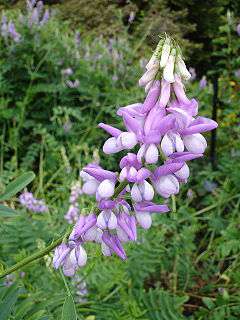Inverted repeat-lacking clade
| Inverted repeat-lacking clade | |
|---|---|
 | |
| Galega officinalis | |
| Scientific classification | |
| Kingdom: | Plantae |
| (unranked): | Angiosperms |
| (unranked): | Eudicots |
| (unranked): | Rosids |
| Order: | Fabales |
| Family: | Fabaceae |
| Subfamily: | Faboideae |
| (unranked): | Hologalegina |
| (unranked): | Inverted repeat-lacking clade (Wojciechowski et al. 2000,[1] 2004[2]) Wojciechowski 2013[3] |
| Tribes[1][4] | |
Incertae Sedis
| |
| Synonyms | |
| |
The Inverted repeat-lacking clade is a monophyletic clade of the flowering plant subfamily Faboideae (or Papilionaceae) that includes the majority of agriculturally-cultivated legumes. It is characterized by the loss of one of the two 25-kb inverted repeats in the plastid genome that are found in most land plants.[5] It is consistently resolved in molecular phylogenies.[1][2][4][5][6][7][8][9][10][11][12] The clade is predicted to have diverged from the other legume lineages 39.0±2.4 million years ago (in the Eocene).[13] It includes several large, temperate genera such as Astragalus L., Hedysarum L., Medicago L., Oxytropis DC., Swainsona Salisb., and Trifolium L..
Description
This clade is composed of five traditional tribes (Cicereae Alef. 1859, Fabeae Rchb. 1832, Galegeae Dumort. 1827, Hedysareae DC. 1825, Trifolieae Endl. 1830) and several genera of the traditional tribe Millettieae (Afgekia Craib 1927, Callerya Endl. 1843, Endosamara R. Geesink 1984, Sarcodum Lour. 1790, Wisteria Nutt.1818, and possibly Antheroporum Gagnep. 1915).[3] The name of this clade is informal and is not assumed to have any particular taxonomic rank like the names authorized by the ICBN or the ICPN.[3] The clade is defined as:
"The most inclusive crown clade exhibiting the structural mutation in the plastid genome (loss of one copy of the ~25-kb inverted repeat region) homologous with that found in Galega officinalis L. 1753, Glycyrrhiza lepidota Nuttall 1813, and Vicia faba L., where these taxa are extant species included in the crown clade defined by this name."[3]
References
- 1 2 3 Wojciechowski MF, Sanderson MJ, Steele KP, Liston A (2000). "Molecular phylogeny of the "temperate herbaceous tribes" of papilionoid legumes: a supertree approach" (PDF). In Herendeen PS, Bruneau A. Advances in Legume Systematics, Part 9. Kew, UK: Royal Botanic Gardens. pp. 277–298. ISBN 184246017X.
- 1 2 Wojciechowski MF, Lavin M, Sanderson MJ (2004). "A phylogeny of legumes (Leguminosae) based on analysis of the plastid matK gene resolves many well-supported subclades within the family". Am J Bot. 91 (11): 1846–1862. doi:10.3732/ajb.91.11.1846. PMID 21652332.
- 1 2 3 4 Wojciechowski MF. (2013). "Towards a new classification of Leguminosae: Naming clades using non-Linnaean phylogenetic nomenclature". S Afr J Bot. 89: 85–93. doi:10.1016/j.sajb.2013.06.017.
- 1 2 Cardoso D, Pennington RT, de Queiroz LP, Boatwright JS, Van Wyk BE, Wojciechowski MF, Lavin M (2013). "Reconstructing the deep-branching relationships of the papilionoid legumes". S Afr J Bot. 89: 58–75. doi:10.1016/j.sajb.2013.05.001.
- 1 2 Lavin M, Doyle JJ, Palmer JD (1990). "Evolutionary significance of the loss of the chloroplast-DNA inverted repeat in the Leguminosae subfamily Papilionoideae". Evolution. 44 (2): 390–402. doi:10.2307/2409416. JSTOR 2409416.
- ↑ Liston A. (1995). "Use of the polymerase chain reaction to survey for the loss of the inverted repeat in the legume chloroplast genome". In Crisp MD, Doyle JJ. Advances in Legume Systematics, Part 7: Phylogeny. Kew, UK: Royal Botanic Gardens. pp. 31–40. ISBN 0947643796.
- ↑ Käss E, Wink M (1996). "Molecular evolution of the Leguminosae: Phylogeny of the three subfamilies based on rbcL-sequences". Biochem Syst Ecol. 24 (5): 365–378. doi:10.1016/0305-1978(96)00032-4.
- ↑ Sanderson MJ, Wojciechowski MF (1996). "Diversification rates in a temperate legume clade: are there "so many species" of Astragalus (Fabaceae)?". Am J Bot. 83 (11): 1488–1502. doi:10.2307/2446103.
- ↑ Doyle JJ, Doyle JL, Ballenger JA, Dickson EE, Kajita T, Ohashi H (1997). "A phylogeny of the chloroplast gene rbcL in the Leguminosae: taxonomic correlations and insights into the evolution of nodulation". Am J Bot. 84 (4): 541–554. doi:10.2307/2446030. PMID 21708606.
- ↑ Pennington RT, Lavin M, Ireland H, Klitgaard B, Preston J, Hu JM (2001). "Phylogenetic relationships of basal papilionoid legumes based upon sequences of the chloroplast trnL intron". Syst Bot. 55 (5): 818–836. doi:10.1043/0363-6445-26.3.537.
- ↑ McMahon MM, Sanderson MJ (2006). "Phylogenetic supermatrix analysis of GenBank sequences from 2228 papilionoid legumes". Syst Biol. 99 (12): 1991–2013. doi:10.1080/10635150600999150.
- ↑ Cardoso D, de Queiroz LP, Pennington RT, de Lima HC, Fonty É, Wojciechowski MF, Lavin M (2012). "Revisiting the phylogeny of papilionoid legumes: new insights from comprehensively sampled early-branching lineages". Am J Bot. 99 (12): 1991–2013. doi:10.3732/ajb.1200380.
- ↑ Lavin M, Herendeen PS, Wojciechowski MF (2005). "Evolutionary rates analysis of Leguminosae implicates a rapid diversification of lineages during the tertiary". Syst Biol. 54 (4): 575–94. doi:10.1080/10635150590947131. PMID 16085576.